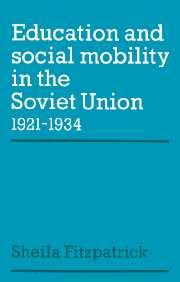3 - The education system: problems of mobility and specialization
Published online by Cambridge University Press: 11 November 2009
Summary
In its first policy statements in 1918, the Russian Narkompros envisaged a single ‘polytechnical’ school, secular and co-educational, which would be attended by all children between the ages of eight and seventeen. The whole school system, from kindergarten to university, was to be ‘a single unbroken ladder…All children must enter the same type of school and begin their education on the same footing, and all have the right to go up the ladder to its highest rung.’
This declaration was approved without discussion by the Soviet government because of its ‘completely uncontroversial nature’. To the Bolsheviks in 1918, the ideal Soviet school system was one appropriate to a future socialist society, in which classes and the capitalist division of labour would have disappeared. But they were thinking not only in terms of the distant future but of the immediate past. The Tsarist education system had not offered an ‘unbroken ladder’, but had been full of discontinuities. Parish-school graduates were not educationally prepared to enter the lowest grade of secondary school; trade schools gave no qualification for further education; graduates of the ‘urban’ or extended primary school – basically a school for peasants and lower-class urban children – could not proceed directly to gymnasia or Realschulen; pupils from the girls’ gymnasia had the educational prerequisites for higher education but were not admitted to the universities as regular students.
- Type
- Chapter
- Information
- Publisher: Cambridge University PressPrint publication year: 1979



